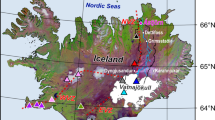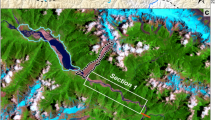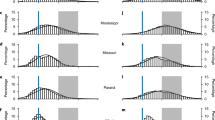Abstract
Deep river canyons are thought to form slowly over geological time (see, for example, ref. 1), cut by moderate flows that reoccur every few years2,3. In contrast, some of the most spectacular canyons on Earth and Mars were probably carved rapidly during ancient megaflood events4,5,6,7,8,9,10,11,12. Quantification of the flood discharge, duration and erosion mechanics that operated during such events is hampered because we lack modern analogues. Canyon Lake Gorge, Texas, was carved in 2002 during a single catastrophic flood13. The event offers a rare opportunity to analyse canyon formation and test palaeo-hydraulic-reconstruction techniques under known topographic and hydraulic conditions. Here we use digital topographic models and visible/near-infrared aerial images from before and after the flood, discharge measured during the event, field measurements and sediment-transport modelling to show that the flood moved metre-sized boulders, excavated ∼7 m of limestone and transformed a soil-mantled valley into a bedrock canyon in just ∼3 days. We find that canyon morphology is strongly dependent on rock type: plucking of limestone blocks produced waterfalls, inner channels and bedrock strath terraces, whereas abrasion of cemented alluvium sculpted walls, plunge pools and streamlined islands. Canyon formation was so rapid that erosion might have been limited by the ability of the flow to transport sediment. We suggest that our results might improve hydraulic reconstructions of similar megafloods on Earth and Mars.
This is a preview of subscription content, access via your institution
Access options
Subscribe to this journal
Receive 12 print issues and online access
$259.00 per year
only $21.58 per issue
Buy this article
- Purchase on Springer Link
- Instant access to full article PDF
Prices may be subject to local taxes which are calculated during checkout



Similar content being viewed by others
References
Karlstrom, K. E., Crow, R., Crossey, L. J., Coblentz, D. & Van Wijk, J. W. Model for tectonically driven incision of the younger than 6 Myr Grand Canyon. Geology 36, 835–838 (2008).
Wolman, M. G. & Miller, J. P. Magnitude and frequency of forces in geomorphic processes. J. Geol. 68, 54–74 (1960).
Sklar, L. S. & Dietrich, W. E. A mechanistic model for river incision into bedrock by saltating bed load. Wat. Resour. Res. 40, W06301 (2004).
Bretz, J. H. The channeled scabland of the Columbia Plateau. J. Geol. 31, 617–649 (1923).
Malde, H. E. The catastrophic late Pleistocene Bonneville Flood in the Snake River Plain, Idaho. US Geol. Surv. Prof. Pap. 596, 1–52 (1968).
Baker, V. R. Paleohydrology and sedimentology of the Lake Missoula flooding in eastern Washington. Geol. Soc. Am. Spec. Pap. 144, 1–79 (1973).
Baker, V. R. & Milton, D. J. Erosion by catastrophic floods on Mars and Earth. Icarus 23, 27–41 (1974).
O’Connor, J. E. Hydrology, Hydraulics and Geomorphology of the Bonneville Flood (Geological Society of America, 1993).
Carling, P. A. Morphology, sedimentology and paleohydraulic significance of large gravel dunes: Altai Mountains, Siberia. Sedimentology 43, 647–664 (1996).
Baker, V. R. The study of superfloods. Science 295, 2379–2380 (2002).
Gupta, S., Collier, J. S., Palmer-Felgate, A. & Potter, G. Catastrophic flooding origin of shelf valley systems in the English Channel. Nature 448, 342–345 (2007).
Lamb, M. P., Dietrich, W. E., Aciego, S. M., DePaolo, D. J. & Manga, M. Formation of Box Canyon, Idaho, by megaflood: Implications for seepage erosion on Earth and Mars. Science 320, 1067–1070 (2008).
Wilkerson, F. D. & Schmid, G. L. The James and Marilyn Lovell Center for Environmental Geography and Hazards Research Vol. 65 (Texas State Univ., 2007).
Brown, T. E., Waechter, N. B. & Barnes, V. E. Geologic Atlas of Texas GA0029 (1983).
Ward, W. C. in Canyon Dam Spillway Gorge, Comal County, Texas—Geologic and Hydrologic Issues (eds Ward, W. C., Molineux, A., Valentine, S. & Woodruff, C. M.) 13–28 (Austin Geological Society, 2008).
Ferrill, D. A. & Morris, A. P. Fault zone deformation controlled by carbonate mechanical stratigraphy, Balcones fault system, Texas. Am. Assoc. Petrol. Geol. 92, 359–380 (2008).
Whipple, K. X., Hancock, G. S. & Anderson, R. S. River incision into bedrock: Mechanics and relative efficacy of plucking, abrasion, and cavitation. Geol. Soc. Am. Bull. 112, 490–503 (2000).
Gilbert, G. K. The rate of recession of Niagara Falls. US Geol. Surv. Bull. 306, 1–31 (1907).
Lamb, M. P., Dietrich, W. E. & Sklar, L. S. A model for fluvial bedrock incision by impacting suspended and bed load sediment. J. Geophys. Res. 113, F03025 (2008).
Komar, P. D. Comparisons of the hydraulics of water flows in Martian outflow channels with flows of similar scale on Earth. Icarus 37, 156–181 (1979).
Costa, J. E. Paleohydraulic reconstruction of flash-flood peaks from boulder deposits in the Colorado Front Range. Geol. Soc. Am. Bull. 94, 986–1004 (1983).
Wolman, M. G. A method of sampling coarse river-bed material. Trans. Am. Geophys. Union 35, 951–956 (1954).
Whipple, K. X. Bedrock rivers and the geomorphology of active orogens. Annu. Rev. Earth Planet. Sci. 32, 151–185 (2004).
Chatanantavet, P. & Parker, G. Physically based modeling of bedrock incision by abrasion, plucking, and macroabrasion. J. Geophys. Res. 114, F04018 (2009).
Howard, A. D. in Rivers Over Rock: Fluvial Processes in Bedrock Channels (eds Tinkler, K. & Wohl, E. E.) 297–319 (American Geophysical Union, 1998).
Luque, F. R. & van Beek, R. Erosion and transport of bed-load sediment. J. Hydraul. Res. 14, 127–144 (1976).
Parker, G. Selective sorting and abrasion of river gravel. II: Applications. J. Hydraul. Eng. 117, 150–171 (1991).
Lamb, M. P., Dietrich, W. E. & Venditti, J. G. Is the critical Shields stress for incipient sediment motion dependent on channel-bed slope? J. Geophys. Res. 113, F02008 (2008).
Bagnold, R. A. An approach to the sediment transport problem from general physics. US Geol. Surv. Prof. Pap. 422-I, 1–37 (1966).
Dietrich, W. E. Settling velocity of natural particles. Wat. Resour. Res. 18, 1615–1626 (1982).
Acknowledgements
Fieldwork was completed with permission from the Canyon Lake Gorge Preservation Society and the US Army Corps of Engineers. We are indebted to Bill Ward for facilitating this access, sharing his field notes and discussions. We thank B. McElroy, P. Myrow, R. Ewing, J. Shaw and D. Mohrig for field assistance. R. Sears provided photographs taken during the flood event.
Author information
Authors and Affiliations
Contributions
M.P.L. was primarily responsible for field measurements, sediment-transport modelling, palaeo-hydraulic analysis and drafting the manuscript. M.A.F. provided field observations immediately following the flood, preliminary hydraulic modelling and assisted in manuscript preparation.
Corresponding author
Ethics declarations
Competing interests
The authors declare no competing financial interests.
Supplementary information
Supplementary Information
Supplementary Information (PDF 1472 kb)
Rights and permissions
About this article
Cite this article
Lamb, M., Fonstad, M. Rapid formation of a modern bedrock canyon by a single flood event. Nature Geosci 3, 477–481 (2010). https://doi.org/10.1038/ngeo894
Received:
Accepted:
Published:
Issue Date:
DOI: https://doi.org/10.1038/ngeo894
This article is cited by
-
Quantitative assessment of the erosion and deposition effects of landslide-dam outburst flood, Eastern Himalaya
Scientific Reports (2024)
-
Late Holocene canyon-carving floods in northern Iceland were smaller than previously reported
Communications Earth & Environment (2021)
-
The importance of lake breach floods for valley incision on early Mars
Nature (2021)
-
Geomorphic effects of recurrent outburst superfloods in the Yigong River on the southeastern margin of Tibet
Scientific Reports (2021)
-
The shaping of erosional landscapes by internal dynamics
Nature Reviews Earth & Environment (2020)



